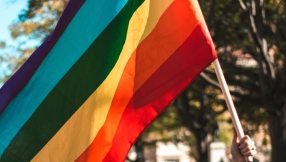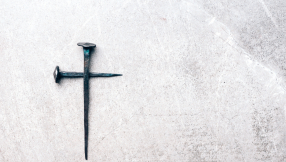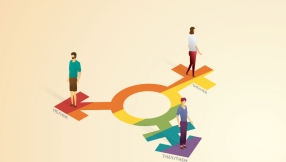Faith and art
Curator and artist Victoria Burgher uses rather unusual materials in her work to display messages. Her piece ‘Sacrifice’ which was made in 2007 and is a sculpture made up of many tiny bread soldiers pinned on a wall in the shape of Jesus on the cross.
“It’s a very strong image from the Christian faith. It was very much to do with the sacrificial element of that but also I was thinking about war and people sent to war in the name of Christianity.
“I made it at the time of the Iraq war, so I was thinking very much of America sending soldiers to fight a new crusade against Islam. It’s much more political, I would say, than about my own faith.”
Although she is a Christian, Victoria would never label herself as a Christian artist but rather an artist who is a Christian. Her work has Christian undertones but it is not subject to Christianity alone.
“My faith or interest in religion and other religions comes through in my own personal artwork. I ‘ve used quite a lot of symbolism, maybe Christian symbolism, but I’ve also used Arabic and Hebrew texts and translations from the old Testament and Hebrew and things from the Koran in Arabic so I’m very interested in all three. I wouldn’t say that I make religious art.”
Victoria recently curated the Three faith forum’s Urban Dialogues project ‘Faith in the City’, an art exhibition that celebrated interfaith collaboration through art. She was intrigued by the similarities between the different faiths.
“In this exhibition, there are Jewish, Christian, Muslim artists, there are artists from other faiths or no faiths, those who would call themselves spiritual. It’s really interesting that there are a number of common themes that come up even though they are all from very different backgrounds,” she says.
Muslim artist Hannah Habibi Hopkin and her project partner Emer Costello recognised a common theme in the faiths that ‘sparked’ inspiration for their exhibition pieces. Hannah gives a brief account of her creations.
“We both were really interested in the use of the metaphor of light in religion and the theme of light being a source of good and a power and the metaphor of that being brought into contemporary urban environment and the fact that light areas are seen as safe, dark areas are seen as bad and what kind of lights you see in darkness so for example you’ll see street lights and night club lights.
“The works that I created were playing on that but giving it a religious twist, so I’ve got the figures of the neon women at prayer. When you see women’s silhouettes you see sort of ‘girls!girls!girls!’ or something of that nature in Soho.
“This was a juxtaposing of that kind of technology that you would see on sexual signs with religious imagery to try and play with the idea of light and darkness.”
Her second piece titled ‘Chasing paradise’ consists of the word ‘Jannah’, written with many light bulbs.
“Jannah means paradise in Arabic and as you can see the light bulbs are flashing and chasing,” she says.
“It’s following its self along and spelling the word ‘Jannah’. That represents the fact that people are chasing paradise so that’s what we’re all going out for.
“It’s searching for pleasures whether they be pleasures forever, or pleasures that are temporary like sex, drugs or music or food and those kind of things.”













